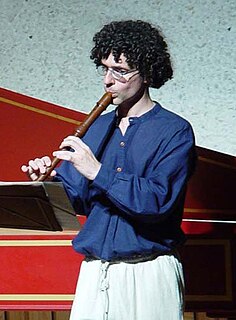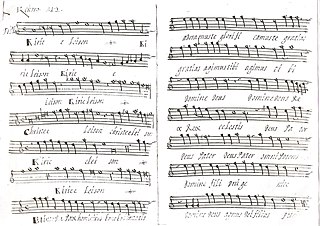Related Research Articles

Juan del Encina was a composer, poet, and playwright, often called the founder, along with Gil Vicente, of Iberian drama. His birth name was Juan de Fermoselle. He spelled his name Enzina, but this is not a significant difference; it is two spellings of the same sound, in a time when "correct spelling" as we know it barely existed.
The villancico or vilancete was a common poetic and musical form of the Iberian Peninsula and Latin America popular from the late 15th to 18th centuries. With the decline in popularity of the villancicos in the 20th century, the term became reduced to mean merely "Christmas carol". Important composers of villancicos were Juan del Encina, Pedro de Escobar, Francisco Guerrero, Manuel de Zumaya, Juana Inés de la Cruz, Gaspar Fernandes, and Juan Gutiérrez de Padilla.
Juan Bautista Comes, aka per Valencian spelling Joan Baptista Comes, was a Spanish Baroque composer who was born and died in Valencia.

Carlos Serrano is a recorder and early woodwinds player. He completed high school studies at Colegio San Carlos in Bogotá. After studying recorder at Oberlin Conservatory in Ohio and Mannes College of Music in New York with Philip Levin, and with Pedro Memelsdorff in Italy, he graduated from the Early Music Institute at Indiana University as pupil of Eva Legene and Michael McCraw. In 1988 he founded the early music ensemble Musica Ficta (Colombia), with which he has specialized in the performance of Latin-American and Spanish renaissance and baroque music. With this ensemble he has performed in Europe, the Americas, the Far and Middle East. He has recorded for the labels Jade (France), Arion (France), Centaur (USA), Arts Music (Germany), Etcetera (Belgium) and Lindoro (Spain). He taught music at Pontificia Universidad Javeriana in Bogotá.

Música Ficta is an early music ensemble founded in Bogotá, Colombia, in 1988. The ensemble is specialized in the performance of Latin-American and Spanish renaissance and baroque music. It has performed in Europe, the Americas, the Far and Middle East, and it has been reviewed, among others, by The Washington Post, Goldberg Magazine, Fanfare, AllMusic and Le Monde de la Musique.
Pau Villalonga was a Spanish composer of sacred polyphony.
Juan Hidalgo de Polanco was a Spanish composer and harpist who became the most influential composer of his time in the Hispanic world writing the music for the first two operas created in Spanish. He is considered by many to be the father of Spanish opera and of the zarzuela.
Sebastián Durón was a Spanish composer.
Juan Francés de Iribarren was a Spanish late baroque composer.
The tono humano was one of the main genres of 17th Century Spanish and Portuguese music.

Miguel de Irízar y Domenzain (1635–1684) was a Spanish Baroque composer.

Jerónimo de Carrión (1660–1721) was a Spanish baroque composer.
Pere Rabassa (Catalan pronunciation: ['peɾə rə'βasə]; was a Catalan composer and musicologist.
Juan Arañés was a Spanish baroque composer. His tonos and villancicos follow the style of those preserved in the Cancionero of Kraków.
Fray Matías Ruiz was a Spanish baroque composer. He was probably the one same Matías Ruiz who was maestro de capilla at León Cathedral in 1665, and then at the Encarnación 1676-1678, and who, still referred to as maestro at the Convent of the Incarnation, Madrid though he no longer could have been, published music for Easter in 1702.
Pedro de Ardanaz (1638–1706) was a Spanish baroque composer. Some of his works are preserved in Latin American manuscripts, and in the El Escorial archive.
Los Músicos de Su Alteza is a Spanish early music ensemble founded by the Saragosse harpsichordist Luis Antonio González in 1992. The ensemble has taken a particular lead in recording music from the archives of Zaragoza's two cathedrals, La Seo and El Pilar, and performs regularly at the Música Antigua Aranjuez festival.
Blas Tardío de Guzmán was a Bolivian criollo composer, one of four notable criollo students of Juan de Araujo. He succeeded Juan Guerra y Biedma as chapelmaster, maestro de capilla, of the Cathedral of Sucre, then called La Plata, in 1745.
Jacinto Valledor y la Calle was a Spanish composer of theatre music and tonadillas. Early success in Barcelona in the 1780s turned to difficulties after a move to Madrid where he was in the shadow of Pablo Esteve. 25 of his tonadillas survive.
Pedro de Lagarto was a Spanish singer and composer of the Renaissance period.
References
- ↑ La música en España Rafael Mitjana, Antonio Álvarez Cañibano, 1993 Don BENITO BELLO DE TORICES, profesor de música en la escuela real de pajes de SM
- ↑ Mariano Soriano Fuertes Historia de la Música Española desde la venida de los Fenicios ...: Volume 4 1859 Don Benito Bello de Torices, maestro de música del real colegio de pages de SMD
- ↑ Mary Neal Hamilton Music in eighteenth century Spain 1971 "The Royal College in Madrid had a noted professor of music in the person of Benito Bello de Torices."
- ↑ Biografías y documentos sobre música y músicos españoles Francisco Asenjo Barbieri, Emilio Casares - 1986 Su padre don Benito Bello de Torices era hijodalgo con ejecutoría dada a su familia por los Reyes Católicos en el año 1498, natural de la villa de Benavente (provincia de Zamora), músico tenor, Maestro de Capilla que había sido de ...
- ↑ Paul R. Laird Towards a history of the Spanish villancico 1997 3.27 Benito Bello de Torices, "Aves, flores, luces, fuentes," estribillo. 111 meas. 70-75 3.28 Benito Bello de Torices, "Aves, flores, luces, fuentes," estribillo, 112 meas. 104-10
- ↑ Inter-American music review: Volumes 11-12; Volumes 11-12 Robert Murrell Stevenson 1990 "Laird looked with greater or less thoroughness at the villancicos of: Francisco Andreu, Pedro Ardanaz, Juan de la Bastida, Benito Bello de Torices, Joseph Casseda, Juan Cedazo, Juan Durango, Mattias Durango, Sebastian Duron, ...
- ↑ The new Grove dictionary of music and musicians: Volume 25; Volume 25 Stanley Sadie, John Tyrrell
- ↑ Musicology Australia: Volume 19; Volume 19 Musicological Society of Australia - 1996 Benito Bello de Torices (c. 1660-r.
- ↑ Actas del XV Congreso de la Sociedad Internacional de Musicología: . 1993 "Entre los identificables con seguridad están Carlos Patino (1600-1675), el más antiguo, Juan del Vado (1625-1691), Diego de Salazar (maestro en Sevilla en 1709), Benito Bello de Torices (-1714), Francisco Sanz (m.